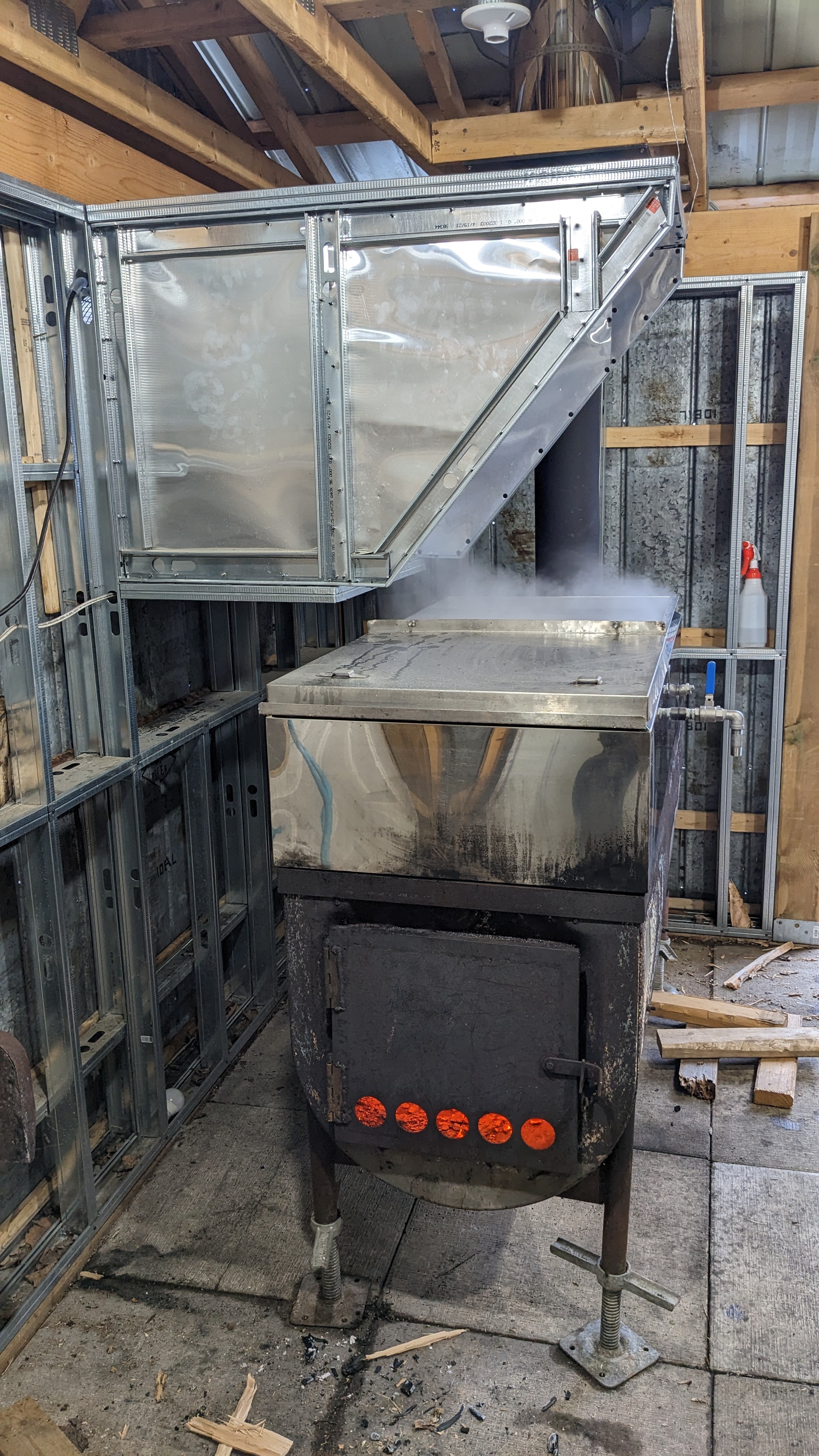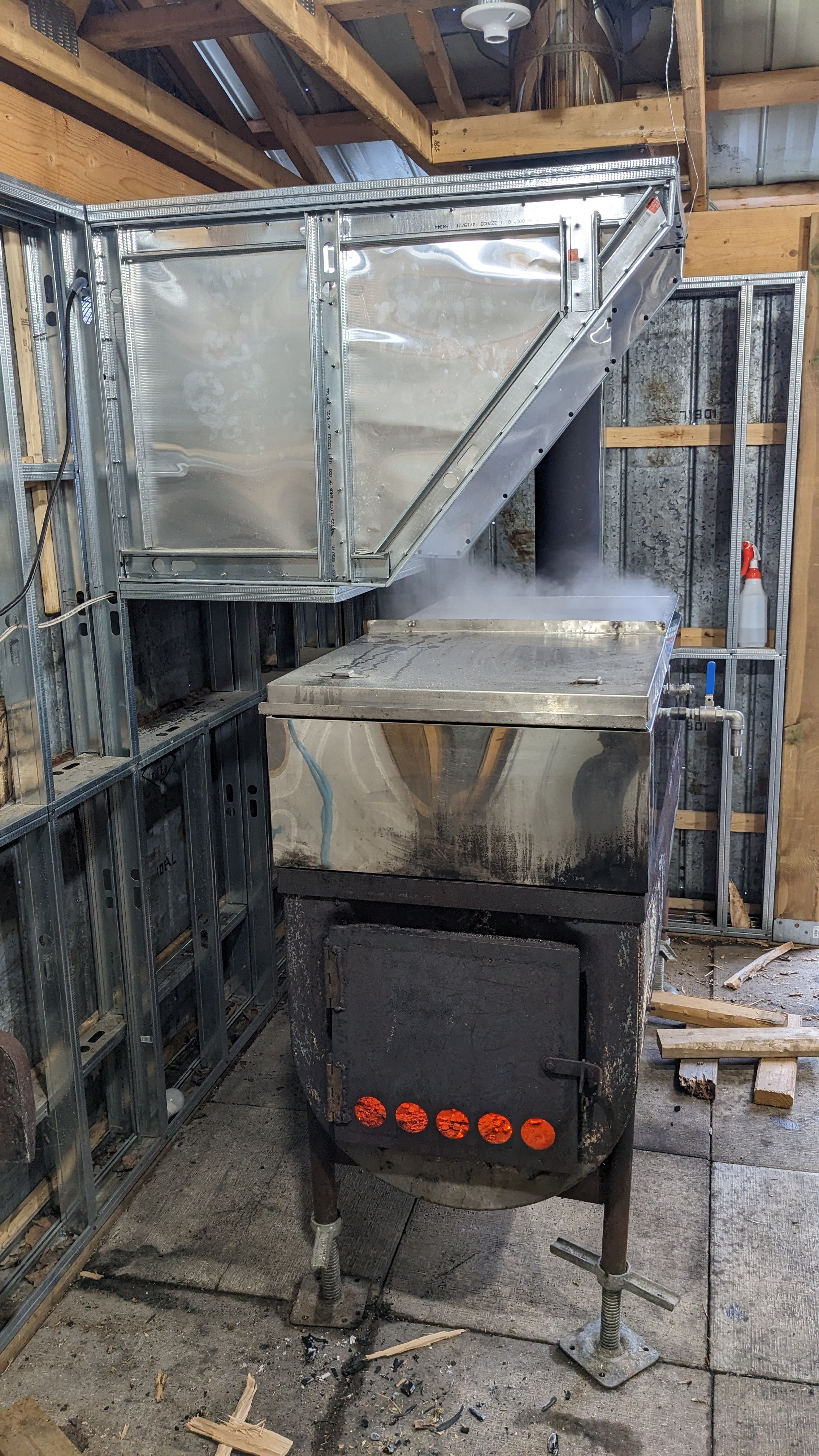cross-posted from: https://lemmy.ca/post/1079003
This is going to be a long post. I will likely have to break it up into parts. So this is Part 1.
In the late winter of 2019 my hand, Lulu, and I built a new oil tank evaporator.
(You can click on the images to see higher resolution versions.)
This is my original evaporator. My wife bought it from a local guy about four years before. It worked ok but I wanted to make improvements.

Note that the door doesn't fit well and the legs are the original oil tank legs which are intended to sit on a concrete floor and not be moved. The body of the evaporator is completely open so I had to pile concrete blocks and piece of steel in there to deflect the heat toward the bottom of the pan.

The pan was steel, folded and soldered and it leaked and was hard to get clean. The hardware was mostly brass and was tenuously connected to the pan.

Lulu (L) and I (R) set out to make improvements.

This is the oil tank that will become the body of our evaporator (and later the body of the evaporator and replaced and improved on this one.
PLEASE NOTE: Cutting an oil tank or any container which has contained flammable liquid will KILL YOU. This is NOT something that you should try unless you know exactly what you're doing. Seriously, it will explode and it will fuck you up.

We used welding magnets and aluminum angle to draw a line around the middle of the tank. I think cut the tank in half. (Read the warning above. I'm not going to tell you how I did this. If you don't know how to do it safely get help or ask someone who does know how to do it safely to do it for you.)

It was getting late when we finished cutting the tank in half so this photo is a bit dark.

We built a frame out of 2" x 2" x 1/8" steel angle. Here we have the long sides clamped to the top of the tank, squeezing the sides straight so that we can measure the length of the required short pieces. The sides of the tank bow out once it is cut in half. You don't want to squeeze it so hard that the side bows in. Just look at where the angle hits the tank and make sure that it's touching the tank along it's full length.

We cut the long and short pieces on the dry cut saw then prepared the corners. We used right angle welding corner clamps to hold them in alignment while we welded them.

Once the corners were welded we did some grinding. So much grinding. When you're an amateur welder the angle grinder is your friend. My hand had never welded before coming to stay with us so she did a lot of learning on this project. I let her do a lot of the welding then came along behind her and did some grinding and touch ups where necessary.

We laid out for, measured, and cut a 2" x 1/2" flat bar door frame.

Next, we cut and welded on the first of three cross bars in the top frame. This one is upside down compared to the other two. This one is the back edge of the pan. Behind it is the read deck where the chimney connector will be.

This little Cub Cadet/Yanmar tractor acted as our welding table for the project. Here you can see the top frame with the rear cross bar. Note also the interrupted weld around the outside bottom of the top frame. The inside of the top frame is continuously welded.
We didn't install the other two cross bars at this point because they would have been in our way as we did the interior welding.

We marked and cut the door opening in the end of the tank.

Then we welded in the door frame. The welds are ugly but we're amateurs.

In this photo we're working on how we're going to attach the half fire bricks to the evaporator. We decided on some 1 1/2" x 1 1/2" x 1/8" angle at the top and bottom with two pieces of the same angle welded back to back with 1/4"-20 studs to attach it to the wall to retain the bricks where they meet.

This was the retainer bar that we built. We slipped the fire bricks into the upper and lower angles then slipped this bar in between the two courses of bricks and bolted it to the side the tank.

In this photo we're doing a fit up to see where the holes need to be drilled for the retaining bar and where the lower angle needs to be welded on.

In this photo we have the lower angle welded in and are just testing to see how the whole setup works. It works well.

Next, we started to build the back and bottom frames of the fire box. The plan was to build a baffle at the back of the first box to direct the heat up and a baffle across the back of the tank to hold the heat against the bottom of the pan.

We cut these three pieces of angle to set the floor even with the bottom of the door to make it easy to drag out the coals and ashes when the boil was done.
This is one of the things that I am going to fix in the next evaporator build. I should have set the floor down the thickness of a half fire brick so that the floor of the evaporator was protected. The heat of the fire built directly on the floor of the fire box caused it to warp.

Most of the flat steel you see in this build came from another oil tank that we cut up as we needed pieces.
Please reread the warning about cutting oil tanks at the beginning of this post.

Here you can see the piece we cut out of the tank above to use as the floor of the first box. We did some cutting and grinding to get a decent fit.

We drilled a series of holes to line up with the middles of the cross bars so we could weld the sheet onto the cross bars.

Everything was dry fit together so that we could make adjustments before we started welding. We ground back the plate a bit at the ends of the cross bars so we could wend the cross bars to the tank well.
Continued in Part 2.



























































